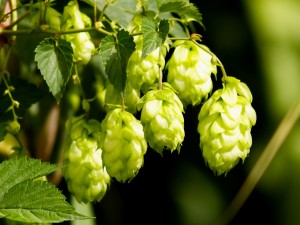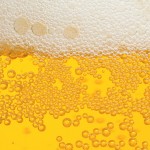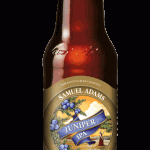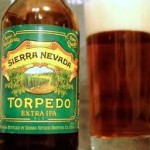
 Humulus lupulus: the hop flower. Fruit of a herbaceous perennial vine, cultivated mainly in northern temperate regions, used extensively as an antibacterial herbal additive.
Humulus lupulus: the hop flower. Fruit of a herbaceous perennial vine, cultivated mainly in northern temperate regions, used extensively as an antibacterial herbal additive.
Which is nice. But for my money, hops have one beautiful, noble purpose: they’re what turns a brew of fermented malt into beer.
We’ve talked before about the elegant simplicity of beer—four simple ingredients are all that’s needed. Water and partially germinated grains, when boiled, unlock the malt sugars. Yeast transforms those sugars into alcohol and carbon dioxide (suds!). And…I suppose you could stop there. Ancient Egyptians and Sumerians, among others, did just that. And to this day we call their staple brew “beer.”
But believe me, you wouldn’t like it. It’s sickeningly sweet. Also prone to bacterial ruination. And so since the early Middle Ages we’ve added that magical fourth ingredient, the pulchritudinous hop flower, to cut the sweetness and to fight microbial infestation. The result ever since has been the bitter flavor profile of beer we all know and love.
The balance and types of hops and malt constitute the taste continuum of beer varieties—from ales and lagers, stouts and bitters. To dangerously oversimplify the brewing arts, it comes down to this: add more hops, and your beer is more bitter.
But here’s the thing. Too damned many brewers are oversimplifying in just that way.
Here in the States we can trace this phenomenon to the explosion of craft brewers we’ve been blessed with since the late eighties and early nineties. Prior to that the American beer industry consisted of those familiar mega-brewers, all putting out a remarkably uniform, bland product, designed to offend no one’s palate. Our beer was rightly mocked around the world.
But now that we’ve been exposed to less pedestrian styles, we’ve developed tastes and preferences that the corporate brewmeisters in Milwaukee and St. Louis never thought we’d aspire to.
So then, enter the IPA, the India Pale Ale. The pinnacle of hoppiness. IPAs are now one of the most popular craft brew styles in the U.S.
You want bitterness? IPA has it in spades; for a very real, historical reason. IPA gets its name, and it’s hop content, from the British Raj, the colonial rule of the subcontinent from 1858 to 1947. British soldiers stationed in India (hell, British everyone in India) wanted beer from home. But the long hot voyage from Old Blighty to the Jewel In The Crown was not kind to beer. “Skunked” is the usual term for beer that’s gone bad, because that’s exactly how it smells. If you can bring yourself to taste it, it’s likewise reminiscent of something emitted from the ass end of a small furry mammal.
So the brewers turned to hops. Lots of hops. Enough to preserve the ale for months aboard ship. The result was far more bitter than anything brewed before, but drinkers came to love it. We still do.
But dammit, why must we pursue everything to excess? This is the trend I’m seeing now: brewers seem to think that if a lot of hops are good, then an insane amount of hops is best. And what could be easier? Just throw in a few extra scoops while your wort is cooling. And if your competition out-bitters you, then throw in some more. We’re living, dear friends, in the times of the Hop Wars.
Let me be the first to say, then, that this war has no winners. Don’t get me wrong, I like hops. I like IPAs, and I like very bitter beer. But the product some of these brewers are putting out doesn’t seem designed to delight my tastebuds. Seems designed to drive me into the arms of Keystone Light. 
Please don’t misinterpret me. I’m not asking for a cessation of IPA innovation. I encourage—hell, I beg brewers to keep on keeping on with new, delightful takes on the classic IPA. But I ask those same brewers: don’t you agree that just adding more and more hops isn’t innovative? Isn’t it just lazy?
Now I have both good news and bad news in this respect. The good news is that the inspiration for this post was my pre-keyboarding consumption of one of the  best damned IPAs I’ve ever had the honor of chugging. The bad news is that it’s a so-called “Limited Release,” which I fear means its days are numbered. Oh, Mr. Koch, I’ve never asked you for anything before (I’ve never needed to!). But please, can’t Juniper IPA be a keeper?
best damned IPAs I’ve ever had the honor of chugging. The bad news is that it’s a so-called “Limited Release,” which I fear means its days are numbered. Oh, Mr. Koch, I’ve never asked you for anything before (I’ve never needed to!). But please, can’t Juniper IPA be a keeper?
Well if not, I’ll toss a salute toward another U.S. brewer that, I think, is doing IPA right. Sierra Nevada creates quite a few extra-hoppy varieties that aren’t  parodies of themselves. I’m partial to the Torpedo, but I’m happy to recommend them all.
parodies of themselves. I’m partial to the Torpedo, but I’m happy to recommend them all.
As for the rest, I’m afraid you’re on your own. After all, just because I like it, or I don’t, doesn’t mean you’ll feel the same. Only way you’ll know, naturally enough, is to give ‘em a try.
So as the pithy headline pun puts it, hop aboard. Yeah, I think the Hop Wars are pyrrhic at best. And yes, I think that as a result the market is being flooded with some crappy IPAs. But market self-correction is everyone’s responsibility. So do your duty: go seek the best IPAs out there, and favor them with your patronage. Let them thus, like gorgeous hoppy phoenixes, rise above the rest. Did I call it a pyrrhic war? In this way, we all might just win the Battle of Too Many Hops.
The I Culture You series–starts way back HERE